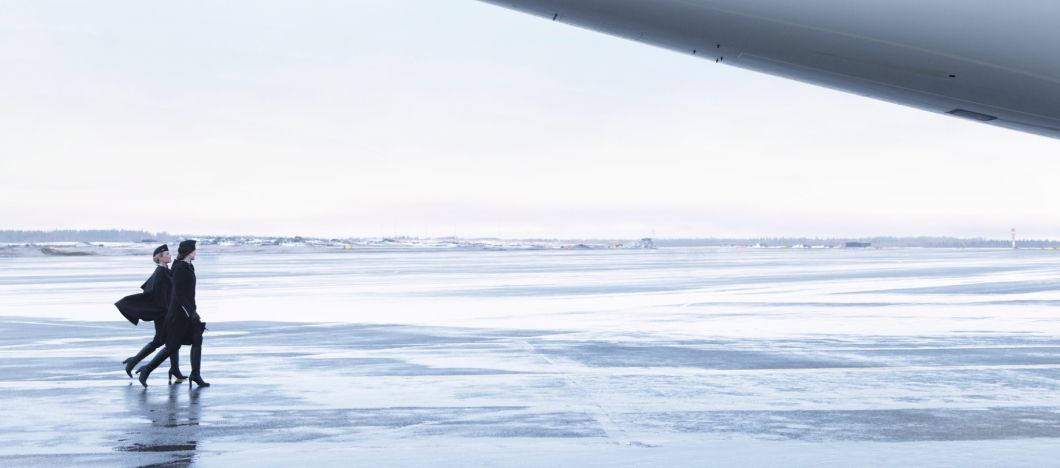Business model
Finnair is a network airline. The network business model is based on a broad network that is built around one or a few airports known as the hub(s). From the hub, the network carrier offers extensive connections to different parts of the network. Finnair's hub is the Helsinki-Vantaa Airport in Finland, from where the company flies to destinations in Asia, North America, Europe, Middle East as well as domestic destinations.
Typical differences between network carrier and low cost carrier
| Network carrier | Low cost carrier |
|---|---|
| Builds an extensive network around one or a few hubs | Point-to-point traffic |
| Intercontinental and continental flights | Focuses more on shorter routes (although intercontinental are being tested in the market) |
| Several different ticket types | One ticket type for everyone |
| Extensive loyalty programs | Constrained loyalty programs or not at all |
| Several different sales channels | Web page-based sales and distribution |
| Part of alliances and joint ventures | Often very little engaged in different alliances or joint ventures |
Finnair’s ability to operate its network safely and punctually from one of the world’s northernmost air traffic hubs is integral to value creation. The transfer of passengers, baggage and cargo to connecting flights is ensured through efficient processes and close cooperation with airport authorities.
Finnair's revenue by product
| EUR million | 2024 | 2023 | Change % |
|---|---|---|---|
| Passenger revenue | 2,419.0 | 2,411.6 | 0.3 |
| Ancillary revenue | 181.8 | 147.8 | 23.0 |
| Cargo | 205.5 | 192.0 | 7.0 |
| Travel services | 242.4 | 237.1 | 2.3 |
| Total | 3,048.8 | 2,988.5 | 2.0 |
Revenue by product 2024, %
Passenger revenue
Passenger revenue i.e. airline tickets sold to consumers are the most important revenue source for Finnair.
In 2024, passenger revenue accounted for 79% of Finnair's total revenue. Approximately 32% of passenger revenue was generated in Asian traffic and 43% in European traffic. The share of Finland was 7% and the share of Middle East 8%, while North America had a share of 9%.
Finnair carried 11.7 million passengers (11.0) in 2024, although the closure of Russian airspace still had an adverse impact on Asian traffic.
Passenger revenue by area, MEUR
| Traffic area | 2024 | 2023 |
|---|---|---|
| Asia | 775.1 | 763.2 |
| North Atlantic | 225.4 | 214.9 |
| Europe | 1,050.0 | 1,045.3 |
| Middle East | 196.1 | 206.3 |
| Domestic | 171.0 | 172.7 |
| Unallocated | 1.4 | 9.3 |
| Total | 2,419.0 | 2,411.6 |
Ancillary revenue
Ancillary revenue is generated by additional services sold to passengers. In 2024, ancillary revenue accounted for approximately 6% of Finnair’s total revenue. Ancillary revenue increased by 23.0% and amounted to 181.8 million euros (147.8). The positive change was mainly explained by the ticket reforms introduced in June 2023, which increased both customers’ freedom of choice and ancillary sales. Advance seat reservations, excess baggage and frequent flyer programme-related revenue were the largest ancillary categories.
Cargo revenue
Finnair receives cargo revenue from shipments transported in the aircraft’s belly. Finnair Cargo is one of the largest air cargo carriers in the Nordics and Baltic region. It specialises in flying high-value items between Europe, Asia and the United States from its Helsinki COOL hub, one of Europe's newest and most advanced air cargo terminal.
In 2024, cargo revenue increased by 7.0% to 205.5 million euros (192.0), driven by higher volumes. Cargo accounted for approximately 7 per cent of total revenue. Finnair Cargo specialises in air cargo traffic between Europe and Asia, but Cargo revenue accumulates also from other geographical areas.
Travel services
Travel services include revenue streams from Aurinkomatkat products, i.e. package holidays to consumers. In 2024, travel services accounted for approximately 8 per cent of Finnair's total revenue. Travel services' revenue increased by 2.3% to 242.4 million euros (237.1), supported by higher volumes but burdened by inflation, weaker consumer confidence and limited hotel availability.
Sensitivities
Due to the seasonality of the airline business, the Group’s revenue and result are generally at their lowest in the first quarter and at their highest in the third quarter of the year.
In addition to operational activities and market conditions, fuel price development has a key impact on Finnair’s result, as fuel costs are the company’s most significant variable expense item. Finnair’s foreign exchange risk arises primarily from fuel and aircraft purchases, aircraft divestments, aircraft lease payments, aircraft maintenance and foreign currency revenue. Significant dollar-denominated expense items are fuel costs and aircraft lease payments. The largest investments, namely the acquisition of aircraft and related spare parts, are also mainly denominated in US dollars. The most significant income currencies after the euro are the US dollar, the Japanese yen, the South Korean won, the Swedish krona, the UK pound, and the Norwegian krona.
The company hedges its currency, interest rate and jet fuel exposure using a variety of derivative instruments, such as forward contracts, swaps and options, in compliance with the risk management policy approved annually by the Board of Directors. Finnair hedges its fuel purchases 18 months forward on a rolling basis. The maximum hedging ratio for the first 3-month period is 93%, while the lower limit is 68% and the average hedging ratio approximately 80%. The hedging ratio decreases towards the end of the 18-month hedging period.
Partnerships
oneworld add
Finnair is part of the oneworld alliance, and it also deploys a deeper cooperation with some of its oneworld partners by participating in Siberia Joint Business and Atlantic Joint Business. Joint Businesses are agreements on the distribution of flights on specific routes and in terms of prices and capacity, and their aim is to increase competitiveness and efficiency for the benefit of passengers.
Finnair's membership in the oneworld alliance increases the size of our global network to more than one 900 destinations in more than 170 countries. Close cooperation with alliance partners particularly in North American and Japanese traffic is a priority for Finnair. Membership in the oneworld alliance and joint businesses strengthen Finnair’s market position and reduce risks related to growth. For customers, they provide an even broader choice of destinations, as well as more flexible routing and pricing options. For airlines, joint businesses are a way to gain benefits typically associated with consolidation in a highly competitive industry without actual mergers, acquisitions or equity transfers between partners. Alliance partnerships and joint businesses have a significant contribution to Finnair’s revenue.
Norra add
Nordic Regional Airlines AB is a regional passenger airline company. Its Finnish subsidiary Nordic Regional Airlines Oy ("Norra") operates ATR turboprop aircraft and Embraer 190 aircraft for Finnair, based on a purchase traffic agreement. The majority shareholder Danish Air Transport (DAT) owns 60% of the shares in Nordic Regional Airlines AB, and Finnair owns the remaining 40 per cent.
Norra operates a fleet of 24 aircraft. All aircraft are leased from Finnair Aircraft Finance Oy. Its route network has been coordinated with Finnair's European flights and long-haul flights. Finnair's influence on the company is based on shareholding and contractual arrangements.
Other partnerships add
Finnair procures certain important operational services from strategic partners, such as ground handling services in the Helsinki hub from Airpro and Aviator, and cargo terminal handling services from Swissport Finland Ltd, as well as engine and component services from Airbus, Rolls-Royce, SR Technics, and Lufthansa Technik. In the area of IT services, Finnair partners with Amadeus, IBM and Nordcloud, among others. The cost and quality targets of these agreements have been determined so as to correspond at least to a good general market level.
Sustainability in partner activity add
All Finnair’s service providers are expected to comply with Finnair’s Supplier Code of Conduct. Finnair aims to secure in its supply contracts the rights to audit the Supplier’s governance and security measures. Finnair’s Code of Conduct and Supplier Code of Conduct can be found here.



